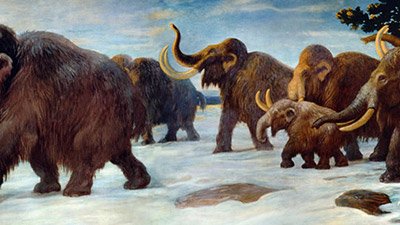Found: Giant Ostrich?
National Geographic News: “Massive Birdlike Dinosaur Unearthed in China”
If you believe the artist’s reconstruction, it’s yet another brick in the wall of evolution: a giant, proto-bird dinosaur, named Gigantoraptor erlianensis, that was described in this week’s issue of Nature.
If you read the article, however, it’s hard to miss the noticeable gap between the dinosaur as it exists in evolutionists’ minds and the dinosaur as it exists today (what’s left of it, that is).
Gigantoraptor is thought to have been some 300 times heavier than other dinosaurs labeled as bird ancestors, throwing a wrench of sorts in the evolutionary works.
Gigantoraptor is thought to have been some 300 times heavier than other dinosaurs labeled as bird ancestors, throwing a wrench of sorts in the evolutionary works. Xing Xu of Beijing’s Institute of Vertebrate Paleontology and Paleoanthropology explains:
“We thought previously that we had a relatively simple pattern—as dinosaurs became smaller in size they became more birdlike,” Xu said. “Now, after the discovery of Gigantoraptor, things get more complicated.”
And scientists are full of ideas for how Gigantoraptor used its feathers:
“We believe Gigantoraptor kept those feathers from its ancestors,” said Xu, who likened the dinosaur’s appearance to that of a mammoth-size ostrich.
Previously the biggest known feathered animal was an 1,100-pound (500-kilogram) prehistoric flightless bird that lived in Australia six to eight million years ago, he added.
The researchers theorize that Gigantoraptor may have used its feathers for display or for incubating its eggs. Past studies suggest oviraptorosaurs may have had long feathers on their arms and bodies for covering their eggs.
“This is one of the hypotheses to explain how long feathers evolved on arms,” Xu said.
The only problem? Scientists didn’t actually find any feathers with the Gigantoraptor remains! The fact is conveniently obscured by the explanation that feathers “rarely fossilize.” In fact, an article from news@nature.com makes only a passing reference to this lack of evidence for the feathers that Xu describes:
Gigantoraptor had long arms, bird-like legs, a toothless jaw, and probably a beak. There are no clear signs as to whether it was feathered. However, judging from its close affinity to other dinosaurs known to have been feathered, Xing Xu [...] speculates that it was. [Emphasis added.]
"There are no clear signs as to whether it was feathered."
As you can see, the true reasoning behind the expectation for feathers comes from the preconceptions that the researchers have. Because of its “affinity” to dinosaurs that are believed to have feathers, Gigantoraptor is passed off as something akin to a comical, giant ostrich.
The problem is, with the bones unlikely to be examined by a creationist paleontologist anytime soon, Gigantoraptor will no doubt be added to the list of “missing links” between dinosaurs and birds. Scant fossils are increasingly being shoehorned into evolutionary roles, with fanciful extrapolations trumping careful analysis of actual unearthed bones; this treatment yields what are often little more than modern-day “Nebraska men.”
And as for a bevy of articles on the supposed evolution of dinosaurs into birds—the details of which evolutionists hotly dispute—see our Dinosaurs Q&A.
Remember, if you see a news story that might merit some attention, let us know about it! (Note: if the story originates from the Associated Press, Fox News, MSNBC, the New York Times, or another major national media outlet, we will most likely have already heard about it.) And thanks to all of our readers who have submitted great news tips to us.
(Please note that links will take you directly to the source. Answers in Genesis is not responsible for content on the websites to which we refer. For more information, please see our Privacy Policy.)

Answers in Genesis is an apologetics ministry, dedicated to helping Christians defend their faith and proclaim the good news of Jesus Christ.
- Customer Service 800.778.3390
- Available Monday–Friday | 9 AM–5 PM ET
- © 2025 Answers in Genesis




